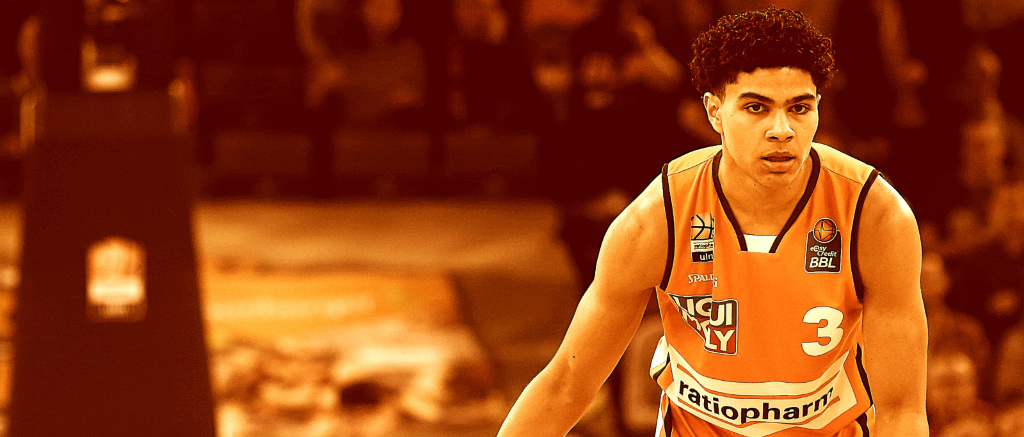One of the hardest things about evaluating overseas prospects as opposed to college players — besides, you know, getting tape — is the consistency of their competition. Sure, most college teams start off their schedules with a few tune up games against lesser competition, but by the time conference play opens up, the level of play is generally pretty competent, even if there are some exceptions in major conferences.
So when a player like ratiopharm Ulm’s Killian Hayes begins to ascend up boards, it’s really tough to figure out which teams he’s playing against are good and which ones are not. The EuroCup is very much second-division basketball. The Bundesliga, Hayes’ domestic competition, is more consistent, but the overall talent level is clearly below even Spain’s ACB, let alone the EuroLeague as a whole. Luka Dončić, for example, did not have this problem, despite what people may have told you coming into the 2018 Draft — he played against the best competition there was outside of the NBA and routinely dominated it.
To put this more simply: How do we go about convincing people that Hayes is worthy of being considered for the top pick this season? This is where game logs and Per 36s aren’t entirely useful. As of this writing, Hayes has played 31 games, which is about the same as the average college season. With that in mind, here’s every drafted player since 2008 to go through a full college season with a 60 TS%, a 2.5 STL%, a 25 AST%, and a 1.5 assist-to-turnover ratio on 20 percent usage and 30 made threes: Lonzo Ball, Nate Wolters, Damian Lillard, Charles Jenkins, Ty Lawson, and Darren Collson (along with Tyrese Haliburton, who will be drafted this year). Ball is the only one of these players to do so while being 6’5 or taller. Also, Ball did not do this while also shooting 88 percent from the line, which Hayes is doing.
Hayes offers a level of defense, passing, and pure shotmaking at his height that very few prospects in recent memory have had. He’s also one of the youngest players in this class, as he doesn’t turn 19 until July 2020. His trajectory simply feels like it has a higher arc than essentially everyone else. He’s improving seemingly game to game, scoring in double figures in nine of his last 10 outings. He’s a better bet to shoot than LaMelo Ball, he’s better at defense — or at least larger — than Cole Anthony or Nico Mannion, and he’s a much better decision maker than Anthony Edwards.
Killian Hayes late game creation. Draws the switch in PnR. Cannot generate separation vs. big, but defense rotates anyway, and Hayes isn't going to miss an opening to skip it to the corner pic.twitter.com/ovjgtPXSTN
— Max Carlin (@maxacarlin) February 13, 2020
This all may sound hyperbolic, but the numbers support it. He’s shooting 58 percent at the rim, 41 percent on threes anywhere that isn’t the left side of the floor (he’s left-handed), and 42.5 percent on in between shots (roughly 10-16 feet away from the rim). He has, I think by any conceivable metric, fairly elite touch compared to the average 18 year old. It really compensates for his average burst, as does his 210 pound frame. What may be even more encouraging for a young lead guard playing against grown men is the fact that opponents are only shooting 43.6 percent (31-for-71) in the paint with Hayes as the primary defender. His size as a guard can be overpowering.
Killian Hayes with a super well-rounded defensive sequence. Clean footwork in lock-and-trail & going over the screen, and really stout on-ball defense by steering him baseline before contesting without fouling. pic.twitter.com/THiX4Xe3fA
— Trevor William Marks (@twmarks_) February 17, 2020
This isn’t a player comp, but the best barometer for a player like Hayes in the NBA — and this is true for Ball and Haliburton as well — is someone like Spencer Dinwiddie, who has made an entire career through basically just Being Tall. He’s a good shooter and passer, but his overall scoring package is just fine, and his defense went from overrated in college to a weak spot in the pros. But because he’s so much taller and stronger than most of the guards he faces, and because he can actually dribble and find people through the defense, he’s an occasionally dominant player. Guards at that height just present problems that even elite NBA defenses have trouble countering. Throw in elite shooting indicators like Hayes has, and it’s hard not to envision him as at least a top-10 prospect in this class.
There are still concerns about Hayes. His spot up shooting is flat out bad for a guard at this stage, which is ameliorated slightly by his ability as a driver and on-ball utility. He turns the ball over a lot, he’s obviously still growing into his body, he’s not a huge factor on the boards for a bigger guard, and there might be a cap on his ceiling that you usually wouldn’t have with a potential No. 1 pick, but that’s true of every conceivable pick this year, including Edwards. I still feel like the overall package of skill, IQ, and physicality Hayes provides overcomes much of these concerns, but they still exist, just as they exist for every top prospect not named Zion Williamson.
Hayes doesn’t play again until Feb. 29, but he’s still going to be playing games and providing a larger sample size through to at least April. Matchups against Ariel Hukporti (REISEN, March 8) and a big time test against Bayern Munich on April 19 loom large for Hayes. But he’s quickly become the best and most intriguing player on his Ulm squad, one of the very best guard prospects in a class loaded with them, and considering positional value being what it is in the NBA, my current choice to be the No. 1 pick in 2020.







